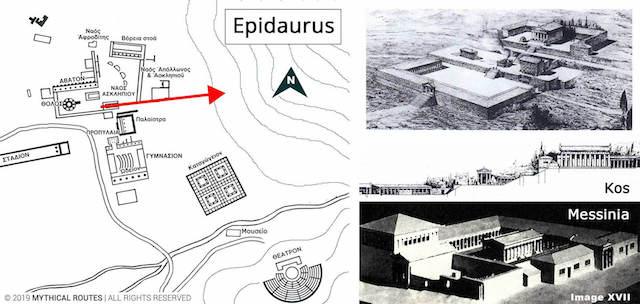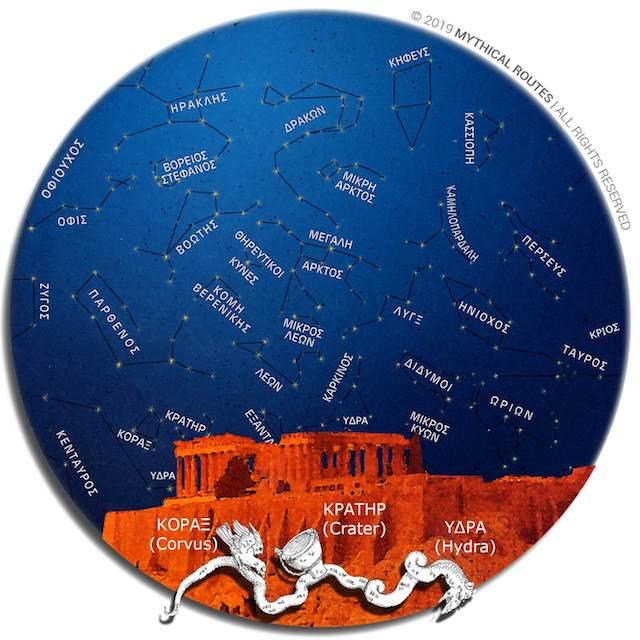
6 minute read
Epidaurus
from Ancient Epidaurus
Hospital Center of Greece
Epidaurus is in proportion the most equipped Medical Center the world has ever seen; with sacred temples, areas for practicing medical science, a gymnasium for the transmission of medical scientific knowledge, but also a kind of physiotherapy facility, bathhouses, an auditorium, theater, wrestling ring, sports center, guesthouses, lodges possibly for walks, discussions on medical issues etc. in a free space with the dimensions of circa 2.000 × 1.000 m. south of mount Arachnaio, therefore protected from the north winds; with branches all over Greece, like that of the Amphiareion of Oropos, which tended to famous clients like Croesus of Lydia, Lysimachus of Thrace, Mardonius of Persia, the Roman Brutus and later on the cruel Sulla. But others beyond Boeotia in most cities, like those of the island Kos and Pergamon.
Advertisement
We can conclude whether the Asclepions offered good services or not to the population, from the fact that the worship of Asclepius adapted to the new worship of Christianity, without it being abolished, as far as the services provided to man are concerned. We can observe that the Asclepions were an important part of the Greek civilization, where the medical center of the island Kos is found on the basic axis Necromanteion - Delos. But also Epidaurus is located on the axis Samothrace - Amyclae.
The Asclepions generally covered a large variety of ailments, such as paralysis, blindness, bile sickness, dropsy, parasites, pediculosis, headaches, pyorrhea, sterility, as well as pregnancy problems, stomachic, but also psychological disturbances. Of course, we should not rule out the possibility of surgical procedures. The patients came from the entire Greek world, both within and outside of Greece. Many of the doctors originating in the Asclepions, found themselves in the kingdoms of the world, like Democedes (6th - 5th century B.C.) in the court of the Persian king Darius I.
Epidaurus
The Theater of Epidaurus, where the various Festivals are held in the summer, is a branch of the Asclepion with the capacity of 15.000 viewers. 500 of them used to stay in the guesthouse as visitors. Given that the capacity of the
theater built by Polykleitos followed the specifications of large festivals and based on the building function of the site, we can safely assume that the Asclepion could tend to at least 4.000 patients. We may then conclude that the service staff should have been at least 2,000 people. Observing, however, the building facilities in image XVII, we may say that the number of the staff was at least twice as large. Namely in a ratio of 2:2, given that in current care centers, of the same luxury, it is inversely, 2:1, but the medical facility is much smaller. All of these people to be hospitalized or part of them were going back and forth from Palea Epidaurus at a distance of 22 km., which would logically take a minimum of 5 hours on foot to travel. Those more severely ill would camp around the area in specially prepared wagons or tents.
The investment that had been made in the site of Epidaurus was huge; suffice it to mention that the gargantuan statue of the god was made out of gold and ivory. Its maintenance was costly, because in contrast to other religious centers, the visitor did not only admire its exterior; in this case the facilities were in everyday use and cleanliness was mandatory. Such expenses can not be covered solely by the contributions of the patients, if there is no volunteer work by the apprentice doctors and the clerical staff, who offered their work out of love for their fellow man. Each of us may not agree with the polytheistic worship, but we can not believe that these people, with all their philosophical infrastructure, were trying to harm others. If that was the case, the Asclepions would not exist, because people would simply not gather there. There were always volunteers in Greece, and the will not cease to exist. If the Asklepieion Image XVII © 2002 A. Baltoyannis
of Epidaurus had economic benefits the first to rush there would be the Athenians, as they did with Eleusis and Delos. As a matter of fact in Athens the cult of Asclepius was established in 420 B.C., during the period of the plague. But again the Asklepion of Athens, west of theater of Dionysus, on the south slope of the Acropolis, was an insignificant unit compared to that of Epidaurus (image XVII), which was oriented towards Ephesus where the Medical Games were held.
According to then with what we mentioned above, a great philanthropist raised in an Asclepion, that of the island of Kos, was Hippocrates (460-377 B.C.) whose "Oath" confirms his ethos, but also the ethos of the Asclepions for the provision of services to the helpless man.
Hippocrates came into conflict with the establishment of his time, regarding the theory of medical science.
Namely, while the priesthood maintained that the nature of illnesses was god sent, he insisted that illnesses come from the human body and the environment. In fact, he rejected the proposition of Pericles, who asked him to join the Asclepion of Athens.
As it is logical for an Asclepion like that of Epidaurus to function properly, there was a hierarchy which operated like that of modern hospitals but based on religion and the structure of the priesthood. This hierarchy included women like modern day nurses.
The afflicted, having bathed in the waters of the spring, would go to sleep in the "inaccessible" area of the sanctuary, waiting to see the god in their dream, who would indicate their treatment modalities. Through this process, the Asklepiads would reach some conclusions and continue recommending diet and herbs. However medical tools were discovered, indicating that surgery was also performed. The remarkable thing is that 70 plates were discovered with narrations of patients who were cured, written in the form of miracles, which were misinterpreted in the Christian period as the way of expression of the patient, where the doctor was also a priest, was not taken into consideration. In addition, through the logic of the intervention of God, the patient psychologically participated in his therapy.
Asclepius is a mythical god, the son of Apollo and the daughter of the Thessalian king Phlegyas, Coronis. With his wife Epione, he had the daughters Aceso, Iaso, Panacea, Aglaea, Hygieia and two sons, Podaleirios and Machaon. The worship of Asclepius started from the city Trikke of Thessaly. From there it spread to Epidaurus and to the whole of the Peloponnese.

Constellation of Ophiuchus (image 5) © 2002 A. Baltoyannis
The period of the celebration of Asclepius was combined with the Eleusinian Mysteries and started towards the end of the month Bohedromion (September - October). It was during the period when Apollo (Sun) transitioned to the sign of Libra. To the North, there was the constellation of Serpens which is linked to
the constellation of Ophiuchus (image 5). Ophiuchus was Asclepius holding the sacred snake, namely the constellation of Serpens.
The entire process is associated with the myth of Asclepius who raised the dead, a fact that caused trouble for Hades because the people were not dying.
Thus Hades complained to Zeus who struck Asclepius down with a lightning bolt. But because Asclepius was the son of Apollo, after the demand of the god, Zeus placed his body among the stars as the constellation of Ophiuchus.

